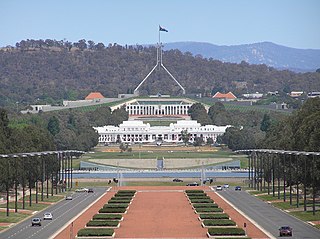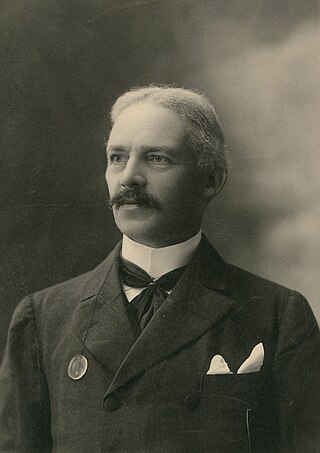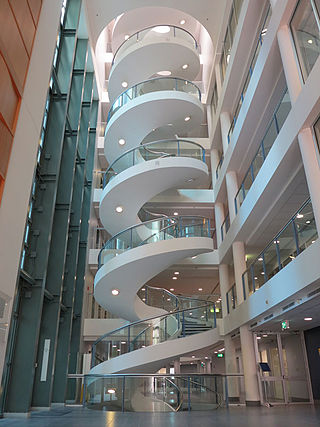Denton Corker Marshall is an international architecture practice based in Melbourne, Australia.
Robin Gibson was an Australian architect, from Brisbane, Queensland.

John Smith Murdoch was a Scottish architect who practised in Australia from the 1880s until 1930. Employed by the newly formed Commonwealth Public Works Department in 1904, he rose to become chief architect, from 1919 to 1929, and was responsible for designing many government buildings, most notably the Provisional Parliament House in Canberra, the home of the Parliament of Australia from 1927 to 1988.

The Perth Concert Hall is a concert hall located in Perth, the capital of the Australian state of Western Australia. Owned by the City of Perth, the hall is the main venue of the West Australian Symphony Orchestra, and also hosts a number of other events and performances. The building itself is located in Perth's central business district, adjacent to the Supreme Court Gardens and Government House. The building has two façades: facing north over St Georges Terrace, and facing south over the Swan River.
Sir Roy Burman Grounds was an Australian architect. His early work included buildings influenced by the Moderne movement of the 1930s, and his later buildings of the 1950s and 1960s, such as the National Gallery of Victoria and the adjacent Victorian Arts Centre, cemented his legacy as a leader in Australian architecture.
Jeffrey Howlett (1928–2005) was a Western Australian modernist architect. Howlett was born in India, but later traveled to London for his studies and then moved to Perth, Australia for training to become an architect. Throughout his life, he won various competitions with his partner Donald Bailey. Howlett acknowledged the reality of late-twentieth-century cities and, through his architecture, suggested a way of making sense of the disorder. He was a founding partner of Howlett and Bailey Architects, along with Bailey, which designed a number of Australian landmarks such as Council House and the Perth Concert Hall.

Council House is a 13-storey office building on St Georges Terrace in Perth, Western Australia. Located beside Stirling Gardens and Government House in the city's central business district, the 49.8-metre (163 ft) building was designed by Howlett and Bailey Architects and opened by Queen Elizabeth II in 1963, after Perth hosted the 1962 British Empire and Commonwealth Games. For most of its history, it has served as the headquarters for the City of Perth.

Dr Norman Kingwell Day is an architect, educator, and writer.
Australian non-residential architectural styles are a set of Australian architectural styles that apply to buildings used for purposes other than residence and have been around only since the first colonial government buildings of early European settlement of Australia in 1788.

George Thomas Temple-Poole was a British architect and public servant, primarily known for his work in Western Australia from 1885.

Daryl Sanders Jackson is an Australian architect and the owner of an international architecture firm, Jackson Architecture. Jackson also became an associate professor at University of Melbourne and Deakin University.
The Sydney School of Architecture, Design and Planning, also known as The University of Sydney School of Architecture, Design and Planning, formerly the Faculty of Architecture, Design and Planning, is a constituent body of the University of Sydney, New South Wales, Australia. The school was established in 1920.

Harold Bryce Mortlock, LFRAIA, was an Australian architect and planner, alongside Sydney Ancher, Stuart Murray and Ken Woolley. His career spanned the era which saw the consolidation of modern Australian architecture.

Michael John Strachan Bryce, was an Australian architect and graphic and industrial designer. He was the husband of the 25th governor-general of Australia, Dame Quentin Bryce.

Peter McIntyre is a Melbourne based Australian architect and educator.
Howlett and Bailey Architects was founded by Jeffrey Howlett and Donald Bailey in 1960, in Perth, Western Australia. They received numerous design awards and commendations from the Royal Australian Institute of Architects and won the competition for the Reserve Bank of Australia Building in Canberra in 1962. Their designs combined Modern style and Classical rationale, which resulted in ordered and axial aspects. Howlett and Baileys Architects’s major projects included the Public Suite, the Beatty Park Pool kiosk and Manager’s house, and the two Australian landmarks the Council House (1962) and the Perth Concert Hall (1973). Howlett and Bailey Architects merged with Cox Architects in 1995 to create Cox Howlett & Bailey Architects. In 1998 the company merged with Forbes & Fitzhardinge Woodland to form Cox Howlett & Bailey Woodland Architects, which still practices today.

Kenneth Frank Charles Woolley, BArch, Hon DSc Arch Sydney LFRAIA, FTSE, was an Australian architect. In a career spanning 60 years, he is best known for his contributions to project housing with Pettit and Sevitt, four time Wilkinson Award-winning architect, including three times for his own house, the first being the 1962 Woolley House in Mosman, and his longstanding partnership with Sydney Ancher and Bryce Mortlock. He is regarded as being a prominent figure in the development of the Sydney School movement and Australian vernacular building.
John and Phyllis Murphy were architects in Australia. Phyllis was also known for her work with wallpaper design and restoration.

William Kerry Hill was a Singapore-based, Australian architect who specialised in hotel design in tropical Asia. His works were known for their features of steeply-pitched pavilion roofs, shaded walkways, and an abundance of water features, affectionately dubbed the "Kerry Hill touch".
Originally known as Stephenson and Meldrum (1921–1937), Stephenson and Turner (1938–1995) was a prominent Australian architectural firm, best known for the pioneering modernism of their numerous hospital designs of the 1930s and 1940s.












